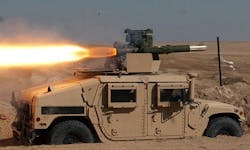Raytheon to build TOW anti-tank missiles for military forces of Jordan and Saudi Arabia
REDSTONE ARSENAL, Ala., 11 Jan. 2017. The Raytheon Co. will build radio-controlled anti-tankmissiles for the military forces of Saudi Arabia and Jordan under terms of a $53.2 million order announced just before Christmas.
Officials of the U.S. Army Contracting Command at Redstone Arsenal, Ala., are asking the Raytheon Missile Systems segment in Tucson, Ariz., to build the Tube-Launched, Optically-Tracked, Wireless-Guided (TOW) munition -- better-known as the TOW missile.
The Army Contracting Command is making the order on behalf of the Army Aviation and Missile Command at Redstone Arsenal. Versions of the TOW missile have been in the U.S. inventory since 1970.
The multimission TOW 2A, TOW 2B, TOW 2B aero, and TOW bunker-buster missile is the one of the primary precision anti-armor, anti-fortification, and anti-amphibious landing weapons used throughout the world today, Raytheon officials say.
Related: Raytheon upgrading anti-tank missile on Marine Corps light armored vehicle (LAV) fleet
TOW missiles can be fired from all TOW launchers, including the Improved Target Acquisition Systems (ITAS), Stryker anti-tank guided missile vehicle (modified ITAS), and Bradley Fighting Vehicles (Improved Bradley Acquisition Subsystem).
TOW launchers can be mounted to a wide variety of vehicles, including the Humvee, and also can be placed in improvised ground fortifications for front-line infantry use. Versions of the TOW missile also can be fired from Light Armored Vehicle–Anti-tank and U.S. Marine Corps AH-1W Cobra attack helicopter.
If the TOW weapon system remains in service with the U.S. military beyond 2050 as military officials plan today, it will have remained in the Pentagon's arsenal for more than 80 years.
To fire the TOW missile, the operator uses an optical missile sight attached to the launcher. The sight is data linked to the missile. Wireless TOW missiles include an RF transmitter added to the missile case and an RF receiver located inside the missile.
Related: Army asks Raytheon to replenish supplies of anti-armor and bunker-busting TOW missiles
When the missile fires, the RF transmitter in the launcher relays information to the missile while in flight. The operator keeps the sight fixed on the target -- even if the target is moving -- to guide the missile to its target. Original versions of the TOW, which were called the tube-launched, optically-tracked, wire-guided missile, trailed a thin wire that relayed information to the missile from the sight.
In 2012 Raytheon experts scored their 100th TOW hit during testing, which marked the engagement of 100 out of 100 targets. During the testing program, which began in 2011, several missiles hit targets as far away as 2.5 miles with flawless precision, Raytheon officials say.
TOW is in service in more than 40 international armed forces and integrated on more than 15,000 ground versions, vehicle- and helicopter-mounted versions worldwide, Raytheon officials say.
On this order Raytheon will do the work in Tucson, Ariz., and Farmington, N.M., and should be finished by this coming October. For more information contact Raytheon Missile Systems online at www.raytheon.com, or the Army Aviation and Missile Command at www.army.mil/info/organization/unitsandcommands/commandstructure/amcom.
Learn more: search the Aerospace & Defense Buyer's Guide for companies, new products, press releases, and videos

